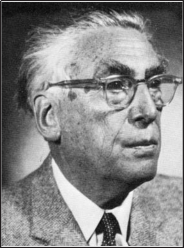- WEINSTEIN
- GERMANY (see also List of Individuals)\
 21.1.1897 Saratov/RU - 6.11.1979 Washington DC/USA\Alexander Weinstein studied at the University of Astrakhan to continue at the Würzburg and the Göttingen Universities until 1914. He submitted a PhD thesis in 1921 to the Swiss Federal Institute of Technology, Zurich and became a Lecturer there in 1927 and one year later at the Hamburg Technical University. From 1933 to 1934 he was at Breslau University and moved from there to Paris until 1940, and then to the USA. In the first year he was a Lecturer at the Free French University, New York, and from 1941 first a Lecturer, and later an associate professor at the University of Toronto, Canada. In 1946 and 1947 he was an associate professor at the Carnegie Institute of Technology, Pittsburgh, and then until 1949 a consultant of the US Naval Ordnance Laboratory in Washington. Finally, from 1950 to 1967, Weinstein was a professor of fluid dynamics at the University of Maryland, College Park MD. Then, he moved to the American University. Washington DC and until 1972 to Georgetown University.\Weinstein traveled throughout his life, partly because of his Jewish blood forcing him to flee from the Nazi regime. In Europe he had collaborated with Einstein and Tullio Levi-Civita (1873-1941), then in Paris with Jacques Hadamard (1865-1963) and with Birkhoff in the USA. His research covered a wide range of topics. He solved the Helmholtz problem for jets with the first uniqueness and existence theorems in a series of papers from 1923 to 1929. He examined boundary value problems with applications in hydrodynamics and electromagnetics. He also introduced a new branch of potential theory and applied the results to flow about an edge, around lenses and spindles.\Fichera, G. (1982). Alexander Weinstein. Atti dell'Accademia Nazionale Lincei 70: 233-240. PPoggendorff, J.C. (1936). Weinstein, Alexander. Biographisch-Literarisches Handwörterbuch6: 2838; 8: 5923-5926. Verlag Chemie: Leipzig, Berlin, with bibliography.Weinstein, A. (1924). Hydrodynamischer Unitätssatz. Mathematische Zeitschrift 19: 263-275. Weinstein, A. (1926). Sur la vitesse de propagation de l'onde solitaire. 2 IUTAM Congress Zurich: 445-448.Weinstein, A. (1936). Les conditions aux limites introduites par l'hydrodynamique. Enseignement Mathématiques 35: 107-125.Weinstein, A. (1949). On surface waves. Canadian Journal of Mathematics 1: 271-278. Weinstein, A. (1978). Alexander Weinstein selecta, J.B. Diaz, ed. Pitman: London. http://www-gap.dcs.st-and.ac.uk/ P http://www-gap.dcs.st-and.ac.uk/ http://www-gap.dcs.st-and.ac.uk/∼history/Mathematicians/Weinstein.html P
21.1.1897 Saratov/RU - 6.11.1979 Washington DC/USA\Alexander Weinstein studied at the University of Astrakhan to continue at the Würzburg and the Göttingen Universities until 1914. He submitted a PhD thesis in 1921 to the Swiss Federal Institute of Technology, Zurich and became a Lecturer there in 1927 and one year later at the Hamburg Technical University. From 1933 to 1934 he was at Breslau University and moved from there to Paris until 1940, and then to the USA. In the first year he was a Lecturer at the Free French University, New York, and from 1941 first a Lecturer, and later an associate professor at the University of Toronto, Canada. In 1946 and 1947 he was an associate professor at the Carnegie Institute of Technology, Pittsburgh, and then until 1949 a consultant of the US Naval Ordnance Laboratory in Washington. Finally, from 1950 to 1967, Weinstein was a professor of fluid dynamics at the University of Maryland, College Park MD. Then, he moved to the American University. Washington DC and until 1972 to Georgetown University.\Weinstein traveled throughout his life, partly because of his Jewish blood forcing him to flee from the Nazi regime. In Europe he had collaborated with Einstein and Tullio Levi-Civita (1873-1941), then in Paris with Jacques Hadamard (1865-1963) and with Birkhoff in the USA. His research covered a wide range of topics. He solved the Helmholtz problem for jets with the first uniqueness and existence theorems in a series of papers from 1923 to 1929. He examined boundary value problems with applications in hydrodynamics and electromagnetics. He also introduced a new branch of potential theory and applied the results to flow about an edge, around lenses and spindles.\Fichera, G. (1982). Alexander Weinstein. Atti dell'Accademia Nazionale Lincei 70: 233-240. PPoggendorff, J.C. (1936). Weinstein, Alexander. Biographisch-Literarisches Handwörterbuch6: 2838; 8: 5923-5926. Verlag Chemie: Leipzig, Berlin, with bibliography.Weinstein, A. (1924). Hydrodynamischer Unitätssatz. Mathematische Zeitschrift 19: 263-275. Weinstein, A. (1926). Sur la vitesse de propagation de l'onde solitaire. 2 IUTAM Congress Zurich: 445-448.Weinstein, A. (1936). Les conditions aux limites introduites par l'hydrodynamique. Enseignement Mathématiques 35: 107-125.Weinstein, A. (1949). On surface waves. Canadian Journal of Mathematics 1: 271-278. Weinstein, A. (1978). Alexander Weinstein selecta, J.B. Diaz, ed. Pitman: London. http://www-gap.dcs.st-and.ac.uk/ P http://www-gap.dcs.st-and.ac.uk/ http://www-gap.dcs.st-and.ac.uk/∼history/Mathematicians/Weinstein.html P
Hydraulicians in Europe 1800-2000 . 2013.
